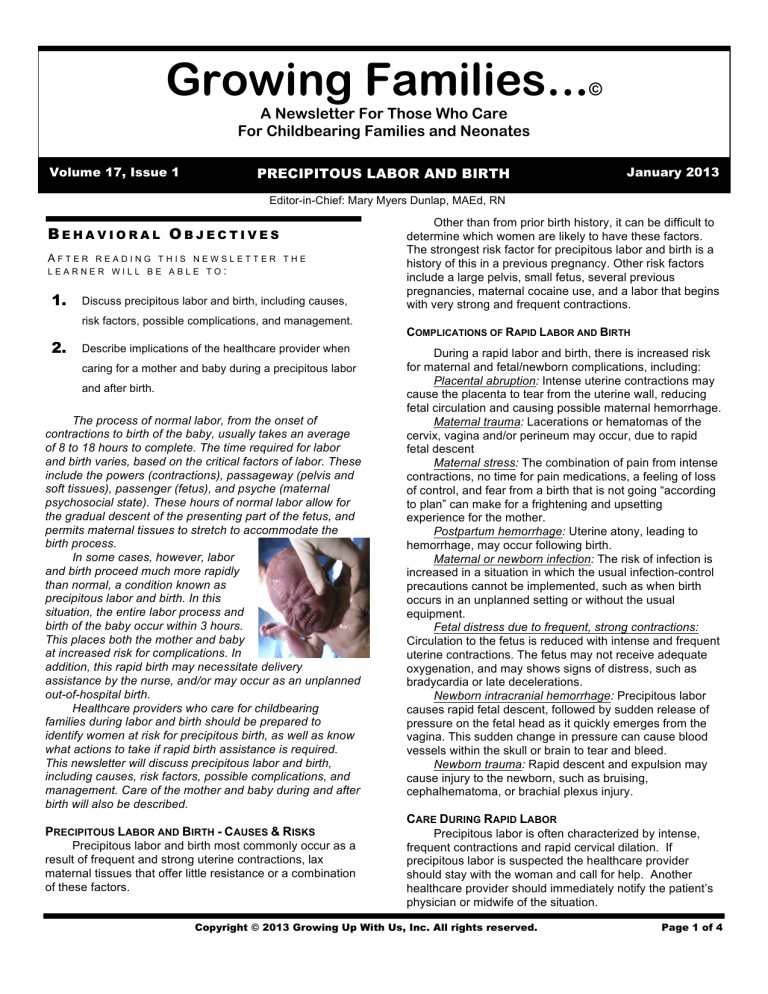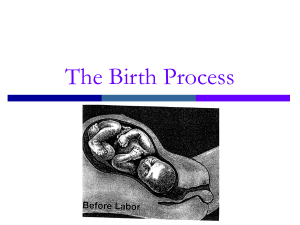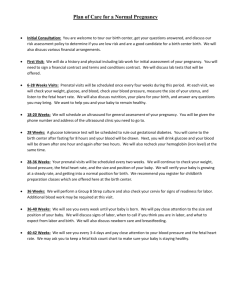Precipitous Labor and Birth

Growing Families...
©
A Newsletter For Those Who Care
For Childbearing Families and Neonates
Volume 17, Issue 1
PRECIPITOUS LABOR AND BIRTH
January 2013
B E H A V I O R A L O B J E C T I V E S
A
F T E R R E A D I N G T H I S N E W S L E T T E R T H E
L E A R N E R W I L L B E A B L E T O :
1.
Editor-in-Chief: Mary Myers Dunlap, MAEd, RN
Discuss precipitous labor and birth, including causes, risk factors, possible complications, and management.
2.
Describe implications of the healthcare provider when caring for a mother and baby during a precipitous labor and after birth.
The process of normal labor, from the onset of contractions to birth of the baby, usually takes an average of 8 to 18 hours to complete. The time required for labor and birth varies, based on the critical factors of labor. These include the powers (contractions), passageway (pelvis and soft tissues), passenger (fetus), and psyche (maternal psychosocial state). These hours of normal labor allow for the gradual descent of the presenting part of the fetus, and permits maternal tissues to stretch to accommodate the birth process.
In some cases, however, labor and birth proceed much more rapidly than normal, a condition known as precipitous labor and birth. In this situation, the entire labor process and birth of the baby occur within 3 hours.
This places both the mother and baby at increased risk for complications. In addition, this rapid birth may necessitate delivery assistance by the nurse, and/or may occur as an unplanned out-of-hospital birth.
Healthcare providers who care for childbearing families during labor and birth should be prepared to identify women at risk for precipitous birth, as well as know what actions to take if rapid birth assistance is required.
This newsletter will discuss precipitous labor and birth, including causes, risk factors, possible complications, and management. Care of the mother and baby during and after birth will also be described.
P
RECIPITOUS
L
ABOR AND
B
IRTH
C
AUSES
& R
ISKS
Precipitous labor and birth most commonly occur as a result of frequent and strong uterine contractions, lax maternal tissues that offer little resistance or a combination of these factors.
Other than from prior birth history, it can be difficult to determine which women are likely to have these factors.
The strongest risk factor for precipitous labor and birth is a history of this in a previous pregnancy. Other risk factors include a large pelvis, small fetus, several previous pregnancies, maternal cocaine use, and a labor that begins with very strong and frequent contractions.
C
OMPLICATIONS OF
R
APID
L
ABOR AND
B
IRTH
During a rapid labor and birth, there is increased risk for maternal and fetal/newborn complications, including:
Placental abruption: Intense uterine contractions may cause the placenta to tear from the uterine wall, reducing fetal circulation and causing possible maternal hemorrhage.
Maternal trauma: Lacerations or hematomas of the cervix, vagina and/or perineum may occur, due to rapid fetal descent
Maternal stress: The combination of pain from intense contractions, no time for pain medications, a feeling of loss of control, and fear from a birth that is not going “according to plan” can make for a frightening and upsetting experience for the mother.
Postpartum hemorrhage: Uterine atony, leading to hemorrhage, may occur following birth.
Maternal or newborn infection: The risk of infection is increased in a situation in which the usual infection-control precautions cannot be implemented, such as when birth occurs in an unplanned setting or without the usual equipment.
Fetal distress due to frequent, strong contractions:
Circulation to the fetus is reduced with intense and frequent uterine contractions. The fetus may not receive adequate oxygenation, and may shows signs of distress, such as bradycardia or late decelerations.
Newborn intracranial hemorrhage: Precipitous labor causes rapid fetal descent, followed by sudden release of pressure on the fetal head as it quickly emerges from the vagina. This sudden change in pressure can cause blood vessels within the skull or brain to tear and bleed.
Newborn trauma: Rapid descent and expulsion may cause injury to the newborn, such as bruising, cephalhematoma, or brachial plexus injury.
C
ARE
D
URING
R
APID
L
ABOR
Precipitous labor is often characterized by intense, frequent contractions and rapid cervical dilation. If precipitous labor is suspected the healthcare provider should stay with the woman and call for help. Another healthcare provider should immediately notify the patient’s physician or midwife of the situation.
Copyright © 2013 Growing Up With Us, Inc. All rights reserved. Page 1 of 4
This call or page should ideally not be made in front of the childbearing family, as any panic detected in the voice of the caller will serve to further increase anxiety.
Frequent assessment and documentation should be made of her contraction pattern, cervical dilation and behavior. An emergency birth pack (“precip” pack) should be kept near the bed. This typically contains items including sterile gloves, scissors, a bulb syringe, towels, hemostats/ cord clamps, and a receiving blanket. Continuous electronic fetal monitoring should be used, time permitting, since there is a risk of fetal hypoxia. Monitoring for signs of possible fetal distress, such as non-reassuring fetal heart rate patterns or meconium staining, is essential. The woman experiencing a rapid labor requires much encouragement and support. There is likely to be little time for pharmacologic pain relief measures, such as epidural analgesia. Therefore, assisting the woman with nonpharmacologic methods of pain relief, such as breathing techniques, positioning, and massage, is helpful.
N URSE -A TTENDED B IRTH
When precipitous birth occurs, the physician or nurse midwife may not be present, and the nurse will assist with the birth. General guidelines are presented here, however the nurse should be familiar with and follow his or her facility’s policies and procedures for precipitous birth.
The laboring woman’s condition should be carefully monitored, watching for signs of imminent birth. These signs may include grunting, saying, “The baby’s coming!”, wanting to push or have a bowel movement, a bulging perineum, or crowning. If these occur, the nurse should immediately call for help, put gloves on and encourage the woman to pant or blow, rather than push. The nurse must appear calm and reassuring, and offer support to the woman, such as, “You’re doing a great job. We’re going to take good care of you and your baby.” To decrease the risk of a newborn fall, the woman should give birth onto the bed surface, rather than up in stirrups.
If the amniotic sac has not broken as crowning occurs, a clamp should be used to tear the sac. As the baby’s head emerges, the dominant hand should be used to support the perineum with a folded towel, to reduce the risk of laceration. With the non-dominant hand, gentle counterpressure is applied to the baby’s head with the palm of the hand, to control delivery of the head. To decrease the risk of perineal lacerations or fetal head trauma, the head should ideally emerge between contractions, while the woman pants or blows. Once the baby’s head is delivered, the fingers are placed on the baby’s neck to check for the presence of a nuchal cord. If there is a loose umbilical cord around the neck, it should be slipped over the baby’s head.
If the cord is too tight to remove, it should be clamped in two places, and carefully cut with the scissors between the clamps and removed. When this occurs, the baby’s oxygen supply has been stopped, so prompt birth is essential.
After quick suctioning of the baby’s nose and mouth with the bulb syringe, gentle downward traction is applied to the baby’s head to deliver the anterior shoulder. The baby is then supported gently upward for delivery of the posterior shoulder, and the remainder of the body will slip out.
The time of birth should be noted. The newborn should be securely held in a slightly downward position to facilitate airway drainage, suctioned again with the bulb syringe, and quickly dried. He/she should be held at the level of the mother’s uterus until the cord is clamped . This prevents the blood loss from the baby back to the placenta that may occur if the newborn is raised above it. Two clamps are applied to the cord several inches from the baby’s abdomen, and scissors are used to cut between the clamps. The newborn can then be wrapped in a dry, warm blanket and placed on the mother’s abdomen. Apgar scores should be assessed at one and five minutes.
The placenta will normally detach from the uterine wall within 15 minutes after birth. Signs include a change in uterine shape from soft oval to a firm, globular mass, the uterus rising in the abdomen, a small gush of dark blood, and lengthening of the umbilical cord protruding from the vagina. Once this occurs, the mother can be instructed to bear down to expel the placenta. The placenta should be placed in a basin so it can be examined by the physician and/or midwife upon their arrival.
Due to the risk of postpartum hemorrhage, the uterus should be gently palpated to assess firmness, and the amount of vaginal bleeding should be observed. Gentle uterine massage can be used for a boggy uterus, and the baby can be put to breast, which enhances uterine contraction. If there are bleeding perineal lacerations, firm pressure should be applied with a towel or gauze pad until the physician or nurse-midwife arrives. As soon as the birth is complete and the mother and newborn are stable, the sequence of events and nursing actions should be documented completely and accurately.
If the precipitous birth occurs outside of the hospital
(unplanned), the same general principles are followed.
Emergency assistance should be obtained by directing another person to immediately call 911, while the woman is supported and reassured. Privacy should be provided for the woman, as much as possible. Items such as newspapers, shirts, coats, and blankets can be used to pad the surface and dry and wrap the baby. A main priority is to keep the newborn warm and dry – breastfeeding and skinto-skin contact with the mother helps to provide nutrition and warmth, as well as promoting uterine contraction to prevent bleeding. If there is no suitable way to cut the cord, the placenta can be wrapped in cloth or paper and then wrapped together with the baby in a blanket for transport to the hospital.
The healthcare provider plays a key role in promoting a safe and effective birth experience for the mother and baby experiencing precipitous labor and birth.
Growing Up With Us, Inc.
PO Box 481810 • Charlotte, NC • 28269
Phone: (919) 489-1238 Fax: (919) 321-0789
Editor-in-Chief: Mary M. Dunlap MAEd, RN
E-mail: editor@growingupwithus.com
Website: www.growingupwithus.com
GUWU Testing Center www.growingupwithus.com/quiztaker/
Copyright © 2013 Growing Up With Us, Inc. All rights reserved. Page 2 of 4






